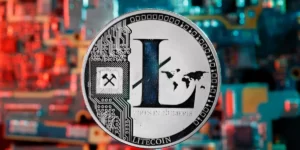XRP, the native token of Ripple, a fintech company focused on cross-border payments, has a passionate community buzzing with a critical question: Can Ripple itself hold XRP back from reaching its record high?
The concern stems from Ripple’s practice of selling XRP on a monthly basis. Some investors worry that a significant price increase would tempt long-term holders to cash out, flooding the market with XRP and potentially stalling the price rally before it reaches its all-time high (ATH) of $3.84, achieved in January 2018.
This $3.84 mark looms large for XRP holders, acting as a psychological barrier. It represents a past peak that the token has yet to recapture, even during the 2021 crypto bull run. As of today, XRP sits at $0.49, reflecting a substantial 87% drop from its ATH. Many fear that upon reaching $3.84 again, frustration and profit-taking from long-term holders could stifle further growth.
However, not everyone in the coin community shares this apprehension. Some argue that retail investors, who might be more prone to selling at this psychological price point, don’t significantly impact XRP’s overall liquidity. Data from the XRP Rich List appears to back this claim. It shows a large concentration of XRP holdings amongst a relatively small number of investors, suggesting retail investors might not be the main drivers of price swings.
On the other hand, XRP enthusiasts like John K from New York believe Ripple suppressing the price would be self-defeating. Ripple holds a significant amount of coin in escrow, valued at roughly $20 billion at the current price.
If XRP were to reach its ATH, the value of Ripple’s holdings would skyrocket to over $153 billion. This substantial financial gain creates a strong incentive for Ripple to actually support XRP’s growth.
Also Read: Ripple’s XRP Price Poised for 19% Rebound? Investor Bets Surge as Breakout Looms
Furthermore, some argue that even if long-term holders sell at $3.84, it could create an opportunity for new investors to enter the market, potentially increasing demand and pushing the price even higher. Ultimately, market forces, not individual entities, dictate the price. Even if Ripple attempted to manipulate the market by selling its holdings, most of their coin is in escrow and not readily available for sale.
The debate around Ripple’s influence on XRP’s price highlights the complex interplay within the cryptocurrency market. While some fear Ripple’s actions could hold XRP back, others emphasize the role of market forces and the potential benefits a price increase would have for Ripple itself. Regardless of speculation, XRP’s future price trajectory hinges on a multitude of factors, including overall market health, adoption rates, and regulatory developments.
Disclaimer: The information in this article is for general purposes only and does not constitute financial advice. The author’s views are personal and may not reflect the views of Chain Affairs. Before making any investment decisions, you should always conduct your own research. Chain Affairs is not responsible for any financial losses.



